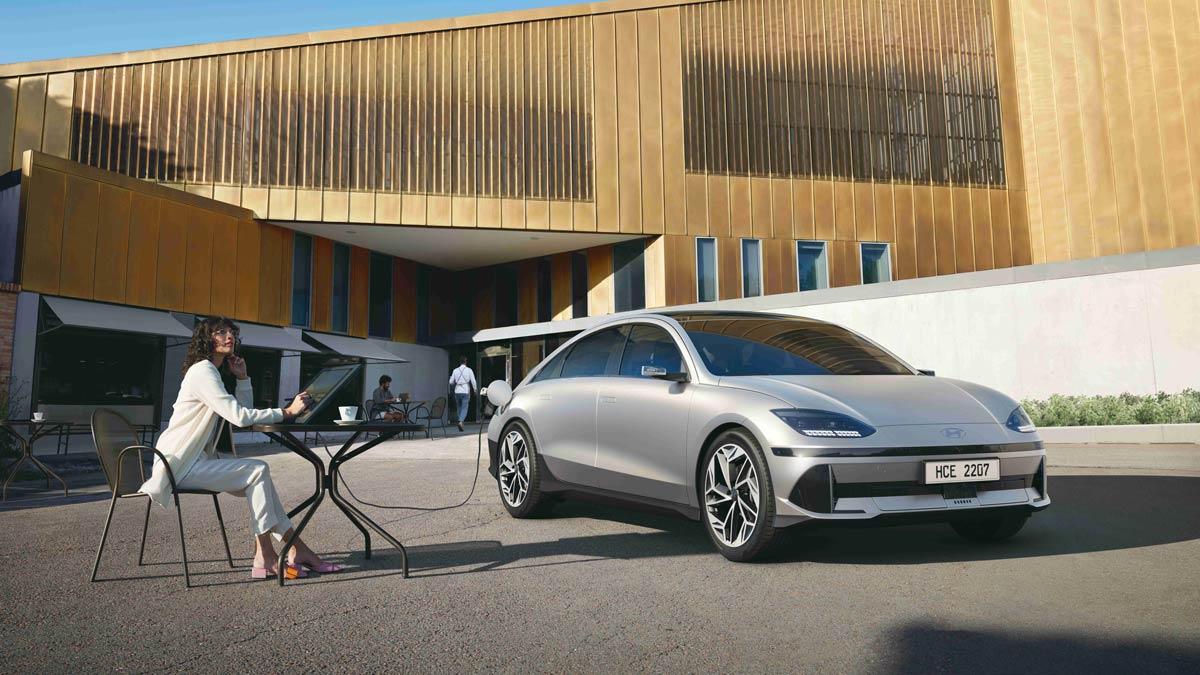Hyundai Motors has unveiled the Ioniq 6, which will go on sale in Korea and selected markets in Europe later in 2022, and in the US in early 2023.
The sporty all-electric sedan joins the Ioniq 5 crossover as new electric offerings from the same e-GMP platform, but although it shares this as well as some key design features, there are some big differences.
For a start, the Ioniq 6 is aimed at a much younger and hip crowd that the Ioniq 5. Like the Ioniq 5, it takes retro automotive design of the past.
In the case of the Ioniq 5, this was Hyundai’s first concept vehicle, the 1974 Pony, which it paid homage to with its angular body accents. The end result, however, was a veritable Tardis that makes for a fun, engaging yet stable and futuristic family vehicle with oodles of space.
The Ioniq 6 on the other hand draws its inspiration from the Saab 92, although its windswept looks bear little resemblance to the Swedish classic, and thankfully so.

Ioniq 6 power, torque and acceleration
What Hyundai have delivered however is a dedicated electric sedan that it can respectably say will rival the omnipresent Tesla Model 3.
Offered in both RWD and AWD variants, the range-topping dual-motor setup delivers 239kW/605Nm torque. Hyundai has not specified the RWD power and torque but expect these to sit around the 160kW/350Nm mark of the Ioniq 5 RWD Dynamiq.
Hyundai has in the Ioniq 6 paid attention to reducing energy consumption. According to figures provided by Hyundai, the Ioniq 6 RWD will chew through just 14Wh/km, delivering 610km (WLTP estimated) range from its 77.4kWh battery.
This would put real-world driving range around the 544km mark, and if Hyundai delivers on its claims it will also mean the Ioniq 6 beats the Tesla Model 3 Long Range on driving range.
It says this can also be attributed in part to the “aerodynamically sculpted silhouette” which means the vehicle has been rated with a 0.21 drag coefficient. But there are also improvements in the battery and motor that we will get into further down.
Ioniq 6 aimed at tech-savvy youngsters
The Ioniq 6 shares with the Ioniq 5 certain design elements including pixel lights at front and back, the concept of a “living space on wheels,” the use of sustainable recycled materials and of course, the e-GMP platform.
But the people that Hyundai thinks will be choosing the Ioniq 6 over the Ioniq 5 are more likely to be those considering sporty electric sedans like the Tesla Model 3 or perhaps more particularly Kia’s EV6.
(This has also led the carmaker’s marketing team to dream up a wild campign that includes selling NFTs – non-fungible tokens, a digital art asset that uses blockchain to identify ownership, that can be bought and sold on the internet, or perhaps more specifically, in the “Metaverse”.)
With this young, hip, Metaverse-dwelling audience mind, Hyundai has added “cool” features that it thinks will appear to this younger demographic, from interior lighting to design features that allow driver and passenger alike to relax, work, meditate or just plain have fun.
Driving the car is increasingly seen as a secondary activity that takes place in between the more enjoyable and industrious moments of life.

But that’s just the point: as the line (and time) between mobility and living is increasingly blurred, legacy carmakers are beginning to see the light that Tesla first ignited when it added gaming, karaoke and other fun features to its electric cars.
For Hyundai, this is quite literally: Features in the Ioniq 6 include “Speed Sync Lighting,” which basically means that as the car speeds up, the lights inside get brighter. Because, when you speed up on the highway, you want to be more visible and noticeable to highway police.
The Ioniq 6’s 5.1 seconds acceleration from 0-100km/hr might not be as quick as the premium Model 3 options but it’s still enough to get you in trouble if you have a heavy foot and don’t have the speed limiting options on.
But back to the inside: the whole interior ambience thing is further emphasised by the ability to choose from a variety of interior lighting themes and 64 colours.
Ioniq 6 battery, motor, vehicle-to-load and charging
Naturally, the Ioniq 6 shares the same charging specs as the Ioniq 5. With an 800-volt architecture, it can charge 0-80% in 18 minutes, and can accommodate 400-volt charging without a secondary plug.
While it uses the same battery chemistry as the Ioniq, Hyundai says it has “deployed several innovative technologies to improve energy efficiency,” including an increase in energy density, addition of a “starship power module” with “next-generation semiconductor”, and on the motor side of things added improved winding technology to improve motor efficiency.
In addition to this, Hyundai says they’ve finetuned the two-wheel-drive transmission to further improve vehicle efficiency.
The addition of interior as well as exterior vehicle-to-load (which has also now been added in a recent Ioniq 5 update) allow the driver to use their vehicle as a virtual office, or camping power source, or sitting at the cafe which quite conveniently has room for you to park next to your outside table (see below).

Unlikely exterior bidirectional charging scenarios aside, Hyundai has given some (although whether enough, we’re not convinced) thought to how V2L might be used inside the car.
Unlike the Ioniq 6, the centre console is joined to the dashboard, but with a straight, flat mini-platform that Hyundai thinks will be perfect for placing a laptop (this driver questions the ergonomics and workplace safety aspects, but will have to wait until we get to sit in one).
There is still a good amount of storage space inside the console, which is largely open, which we like.
While local trims and specs are yet to be revealed, it looks like the “relaxation seat” that is still a standard option in the Ioniq 5 Techniq AWD is an optional extra for the Ioniq 6.
Pricing is also yet to be announced, even for overseas markets. However, as the Ioniq 6 has been described as “premium appeal without premium pricing”, we expect it to at least fall under the $80,00 mark when it arrives here in the yet-to-be-determined future (maybe by mid-late 2023? stay tuned.)

Bridie Schmidt is associate editor for The Driven, sister site of Renew Economy. She has been writing about electric vehicles since 2018, and has a keen interest in the role that zero-emissions transport has to play in sustainability. She has participated in podcasts such as Download This Show with Marc Fennell and Shirtloads of Science with Karl Kruszelnicki and is co-organiser of the Northern Rivers Electric Vehicle Forum. Bridie also owns a Tesla Model Y and has it available for hire on evee.com.au.












